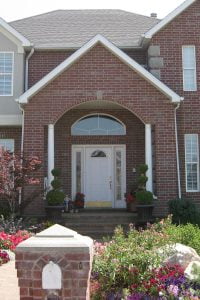Energy-efficient updates are a good idea any time of the year. There is, however, a more measurable and meaningful reason to go green during the colder months. You can ease the pain of the winter heating bill by making a few simple changes to your outside doors. These simple changes can enhance the energy efficiency of your entire house, keeping you warmer and saving you money all winter long.
Doors and windows are basically large holes cut in the thermal envelope of your house. Even under the best of conditions, the R-value (the measure of the thermal resistance of a material or assembly) of doors and windows is significantly less than that of the wall in which they sit. Without the proper unit or correct installation, air and heat may be leaking out, driving up your energy bill.
There are three common types of exterior door materials: wood, fiberglass and steel. Of these, wood is the most beautiful, but it is also the least energy efficient. Insulated doors have a core of foam insulation, which increases thermal resistance. Any glass within the door frame should also be insulated, meaning two panes of glass at a minimum. This is especially important if the doors are mostly glass, such as patio (sliding) or French doors.
Energy.gov explains the energy efficiency of the different doors by the R-values:
“The R-values of most steel and fiberglass-clad entry doors range from R-5 to R-6 (not including the effects of a window). For example: A 1½ inch (3.81 cm) thick insulated door without a window offers more than five times the insulating value of a solid wood door of the same size.
“Glass or ‘patio’ doors, especially sliding glass doors, lose heat much faster than other types of doors because glass is a very poor insulator. Most modern glass doors with metal frames have a thermal break, which is a plastic insulator between the inner and outer parts of the frame that interrupts the transfer of cold to the interior of the assembly.”
“Models with several layers of glass, low-emissivity coatings, and/or low-conductivity gases between the glass panes are a good investment, especially in extreme climates,” according to energy.gov.
Over the long run, the additional cost of the unit is paid back many times over in energy savings.
Once you have selected an energy-efficient door unit, care must be taken to install it correctly. Proper weatherstripping is critical to keeping air from leaking. Updating the weatherstripping on an existing front door is a useful exercise, even if you are not replacing the door.
Good weatherstripping “will withstand the friction, weather, temperature changes, and wear and tear associated with (its function). For example, when applied to a door bottom or threshold, weatherstripping could drag on carpet or be eroded as a result of foot traffic. The weatherstripping you choose should seal well when the door is closed while allowing it to still open freely,” according to energy.gov.
“Felt and open-cell foam weatherstripping tend to be inexpensive, but they are susceptible to weather and ineffective when it comes to blocking airflow. … Vinyl, which is slightly more expensive, but it holds up well (to traffic) and resists moisture,” according to energy.gov.
Metal weatherstripping (bronze, copper, stainless steel and aluminum) is the most expensive option, but it will last for years and can add a nice aesthetic touch to older homes, according to energy.gov.
When buying or replacing patio doors, keep in mind that swinging doors offer a much tighter seal than sliding doors. After years of use, the weatherstripping on a sliding door wears down and starts to leak air. You can replace the weatherstripping on some glass door models, but on others you may need to replace the entire unit.
Energy-efficient home improvement may also warrant you a tax credit. The original energy-improvement tax credits expired in 2013, but the IRS says that if you didn’t reach the $500 lifetime limit in prior years you may still be able to benefit from the tax credit for upgrades in 2014. The credit is 10 percent of the cost of the product, not including installation.
If you are seeking a tax credit, make sure the door you choose is a qualifying product. The manufacturer’s website should indicate whether or not a product qualifies for tax credits. Keep this written certification with your tax records if you choose to claim the tax credit. Obviously, doing energy-efficient upgrades has more benefits than a possible 10 percent tax credit, but such extra benefits are always welcome.
1 comment on this story Remember, any upgrade should always coincide with your master plan for your house. If you have future plans to remodel the exterior of your house, consider waiting to upgrade your front door or at least choose a door style that will work with the new façade.
You probably don’t want to replace your front door in a year or two if you install a new one now. Even worse would be to have to design your curb appeal update around a door style if it wasn’t chosen with the future project in mind. Your front door is one of the most important features on the exterior of your home. It should be the “star of the show” and project the image you want for both your home and your family, as well as keeping you warm and toasty all winter.
Ann Robinson and Annie V. Schwemmer are the principal architects and co-founders of a residential architectural firm focused on life-changing remodeling designs at RenovationDesignGroup.com. Send comments or questions to ask@RenovationDesignGroup.com


